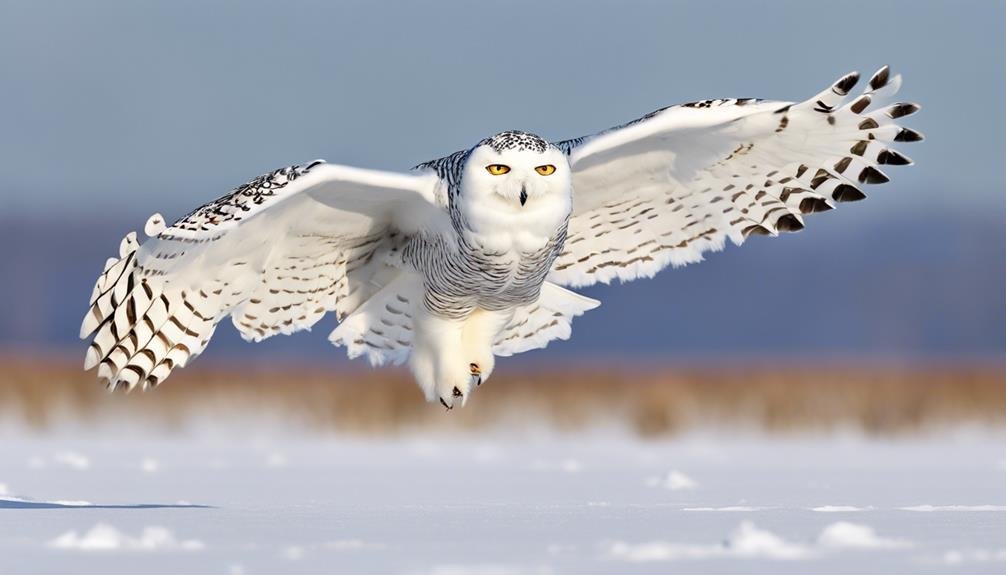Key Takeaways
Key Takeaways:- Diurnal hunting techniques: Snowy Owls showcase exceptional hunting skills during the day, utilizing their keen eyesight and swift movements to capture prey efficiently.
- Silent flight capabilities: The Snowy Owls’ ability to fly silently enables them to sneak up on unsuspecting prey without alerting them, giving them a strategic advantage in hunting.
- Territorial nature: Snowy Owls are fiercely territorial, defending their hunting grounds and ensuring a stable food supply for survival in the Arctic.
- Unique adaptations: With specialized features like dense feathering for insulation and powerful talons for gripping prey, Snowy Owls have evolved unique adaptations that enhance their hunting prowess in the harsh Arctic environment.
- Significance in the Arctic ecosystem: By mastering these hunting behaviors, Snowy Owls contribute to the delicate balance of the Arctic ecosystem, playing a vital role as skilled predators in this extreme environment.
Hunting Techniques of Snowy Owls
Snowy Owls’ Strategic Perching Snowy owls exhibit a unique hunting strategy by perching in strategic locations and patiently scanning their surroundings for potential prey. These Arctic predators rely on their exceptional visual acuity and acute hearing to detect movement, especially during the diurnal hours. Their silent flight capabilities allow them to approach prey without being detected. Swift Strikes with Sharp Talons Once a target is spotted, snowy owls swiftly capture small mammals like lemmings using their sharp talons. Their remarkable eyesight plays a crucial role in accurately pinpointing prey, while their acute hearing aids in tracking movements even in the snow-covered landscape. This precise coordination of sight and sound ensures successful strikes on unsuspecting prey in the harsh Arctic environment.Snowy Owl Prey Selection
Snowy Owl Prey Selection in the Arctic Habitat
Specialization in Hunting Lemmings
Snowy Owls showcase a remarkable specialization in hunting lemmings, which make up a significant portion of their diet. Their keen sense of prey selection is evident in their focus on these small rodents.Targeting a Variety of Small Mammals
In addition to lemmings, Snowy Owls also target other small mammals like mice, voles, and rabbits for sustenance. This diverse prey selection highlights their adaptability to the resources available in their Arctic environment.Opportunistic Feeding Habits
Snowy Owls exhibit opportunistic feeding habits, consuming birds, fish, and carrion when the opportunity arises. This flexibility in prey selection allows them to thrive in their harsh Arctic habitat.Patience and Precision in Hunting Behaviors
Their hunting behaviors reflect patience and precision, as Snowy Owls carefully stalk and wait for the perfect moment to strike their prey. This strategy ensures successful captures in the challenging Arctic landscape.Snowy Owl Hunting Territories

Snowy Owl Camouflage Strategies
Snowy Owl’s Arctic Camouflage: The Snowy Owl’s white and dark brown feather patterns serve as a perfect disguise in the snowy Arctic landscape, allowing them to blend seamlessly with their surroundings. Insulation for Arctic Survival: With their thick down and multiple layers of feathers, Snowy Owls are well-equipped to withstand the cold Arctic temperatures, ensuring they can focus on hunting without being affected by the harsh environment. Diurnal Hunting Tactics: Unlike many other owls, Snowy Owls are diurnal hunters, using their effective camouflage to surprise and capture prey during the daylight hours in the Arctic regions. Adaptation to Seasonal Changes: The intricate feather patterns of Snowy Owls undergo seasonal changes, adapting to match the shifting colors of the Arctic environment. This dynamic camouflage strategy enhances their survival and hunting success in different seasons.Snowy Owl Hunting Efficiency
Snowy Owl Predatory Skills Snowy owls exhibit exceptional predatory skills, showcasing a remarkable blend of patience and precision in capturing prey in the Arctic. Their hunting efficiency is a testament to their well-honed skills. Superior Eyesight for Spotting Prey In the vast Arctic landscape, snowy owls rely on their superior eyesight to spot prey from afar, allowing them to successfully hunt down their target with accuracy. Sit-and-Wait Hunting Technique Employing a sit-and-wait hunting technique, snowy owls demonstrate remarkable patience as they wait for the perfect moment to strike, ensuring a successful hunt. Silent Flight for Unnoticed Approach The snowy owl’s silent flight further enhances their hunting prowess, enabling them to approach prey unnoticed, adding a stealthy element to their hunting strategy. Adaptation to Changing Prey Availability Adaptation is crucial for snowy owl populations as they adjust their hunting strategies based on the availability of lemmings, their primary food source, showcasing their ability to thrive in challenging environments. Keen Eyesight, Patience, and Silent Flight Through a combination of keen eyesight, strategic patience, and silent flight, snowy owls demonstrate impressive hunting efficiency in the Arctic, highlighting their prowess as skilled predators in their habitat.Frequently Asked Questions
What Is the Snowy Owls Hunting Strategy?
What hunting strategies do snowy owls use? Snowy owls employ silent swooping, camouflaged perches, wide-eyed focus, precision strikes, swift descents, patient waiting, acute hearing, agile flight, and ambush tactics to hunt efficiently. Their techniques are adaptable to prey availability and Arctic conditions.What Is the Behavior of a Snow Owl?
What is the behavior of Snowy Owls? Snowy Owls exhibit a range of behaviors, from impressive mating rituals to territorial disputes. They are nocturnal hunters with exceptional hunting success rates, relying on their keen prey detection and silent flight for efficient predation.How Are Snowy Owls Adapted for Hunting?
Question: How do snowy owls excel in hunting? Answer: Snowy owls excel in hunting due to their keen eyesight for spotting prey, acute hearing to detect movements, silent flight for stealth, and sharp talons for precision strikes. Additionally, they adapt with patience, camouflage, and cold-resistant features.What Do Arctic Owls Hunt?
What do Arctic owls hunt? Arctic owls, like Snowy Owls, primarily hunt Arctic rodents and small birds. They have a diet focused on lemmings. Their hunting techniques include camouflage skills, silent flight, night vision, and pouncing prey. Additionally, they engage in territory marking and nest protection to ensure successful hunting in the Arctic.What Are the Best Hunting Behaviors Snowy Owls Use in the Arctic?
Snowy owls are skilled hunters, utilizing keen eyesight and silent flight to locate prey across the icy Arctic. They often perch still for long periods, scanning for movement before swooping in. If you’re observing them, snowy owl hunting tips suggest patience and understanding their favored perching spots for successful encounters.


